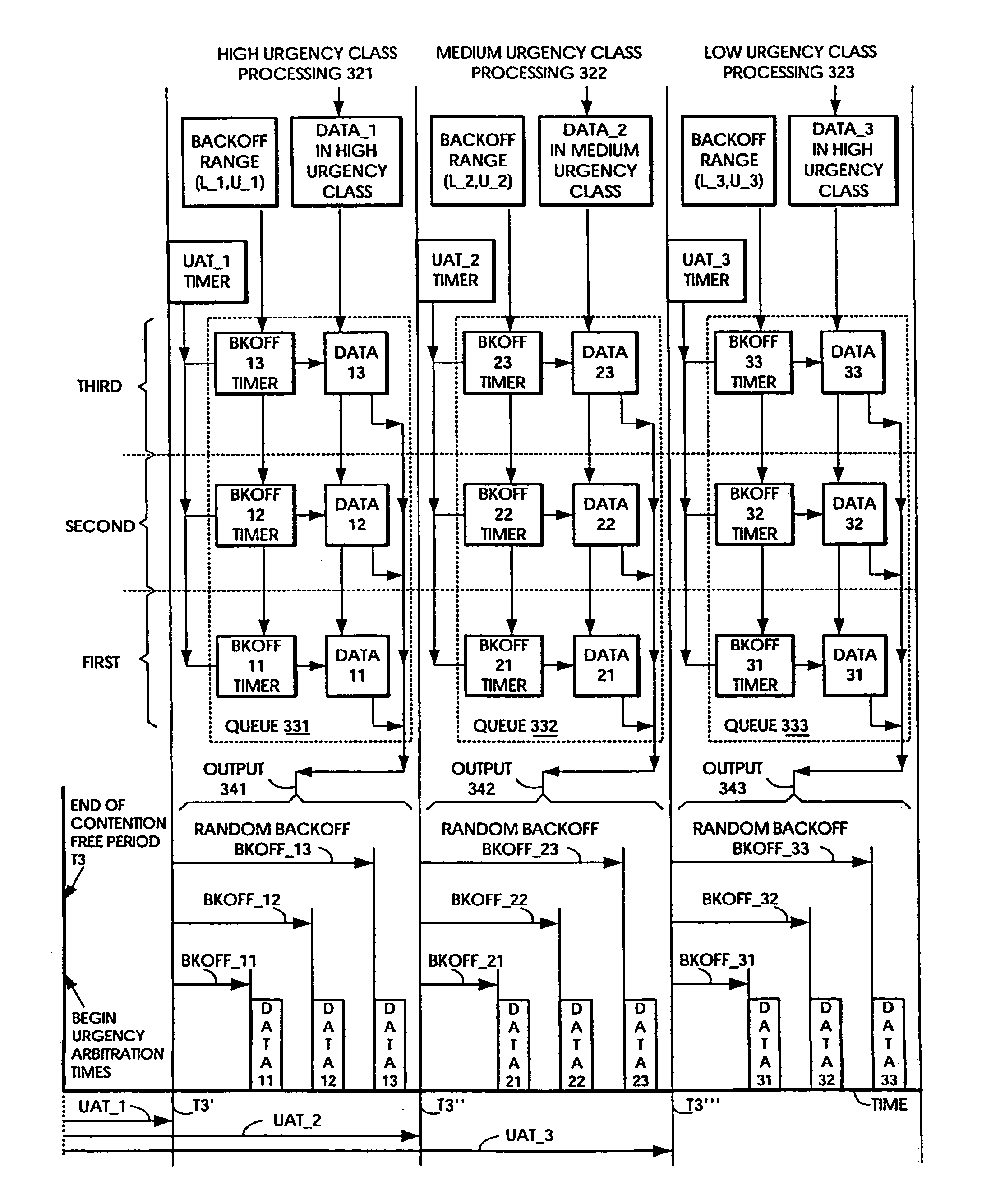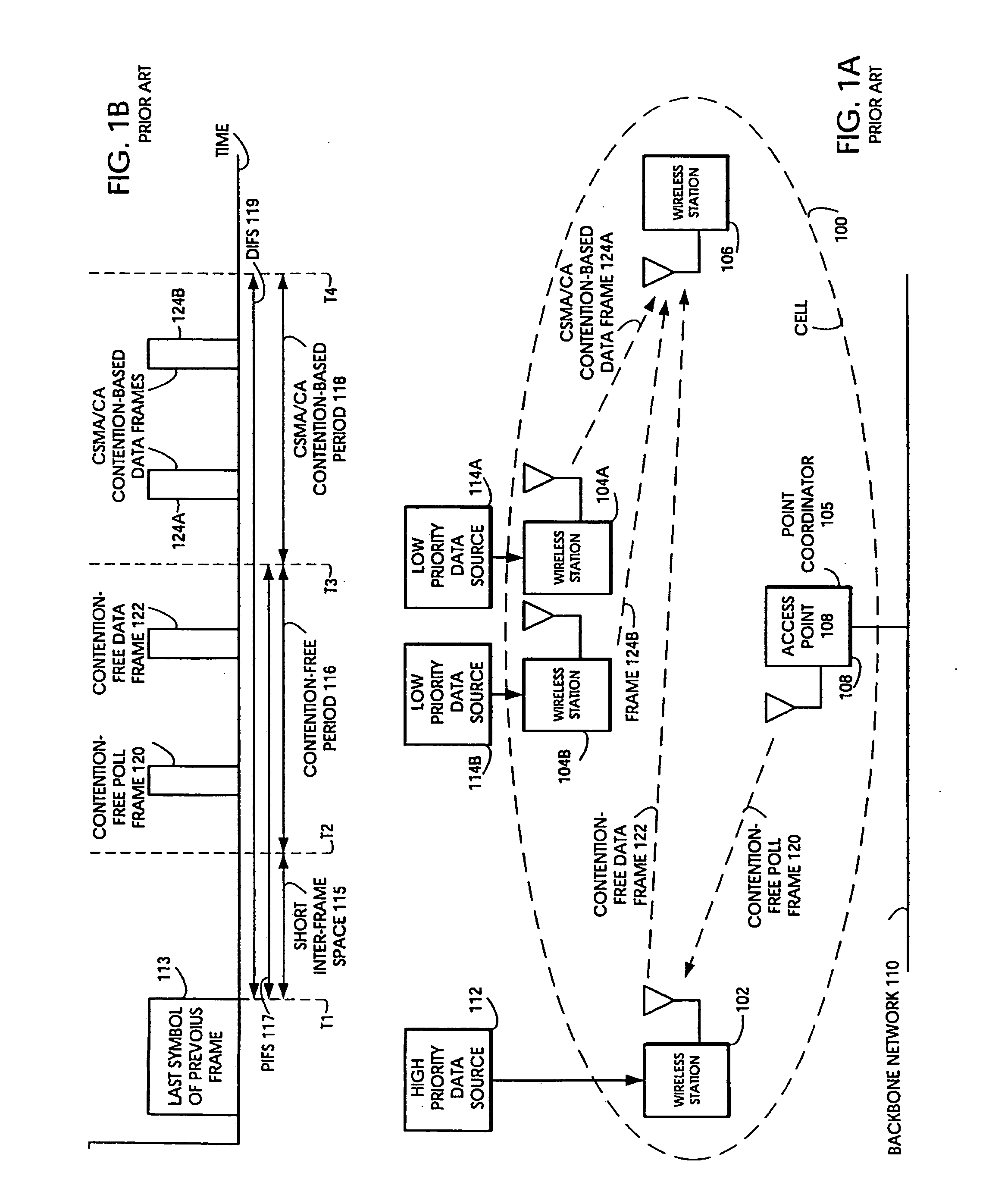Random medium access methods with backoff adaptation to traffic
a random medium access and traffic technology, applied in the field of telecommunication methods, can solve problems such as preventing back-to-back re-transmission, protocol instability, and protocol also suffering from hidden terminal problems
- Summary
- Abstract
- Description
- Claims
- Application Information
AI Technical Summary
Benefits of technology
Problems solved by technology
Method used
Image
Examples
example 1
Estimates b1
[0334] Determine desired scaling step size ST and specify constants CR=ST+1,andCD=1(ST+1)nstart=average·number·of·terminalspstart=1U+1;
where U is the upper bound on the starting backoff distribution
bstart=nstart·pstart
[0335] Algorithm Logic
[0336] Step 0 Initialize
n0=nstart;
p1=pstart;
b0=bstart
[0337] Block A [Perform the following steps repeatedly.]
[0338] Step 0 Estimate b1, the number of backlogged stations with backoff value equal to 1, using feedback data and the Estimation Procedure1.
1An Estimation Procedure is presented below.
[0339] Step 1 Invoke Block S [Scaling check]
[0340] Step 3 End of Block A
[0341] Block S [Scaling check]
[0342] Step 0 Check whether scaling up is required; that is, if b1≧CR, go to Step 1; otherwise, go to Step 2. [0343] Step 1 Invoke the Scaling Algorithm to scale up by the adjustment factor R=ST update p1←p1·CD; set b0=b1; and go to Step 5.
[0344] Step 2 Check whether scaling down is required; that is, if 2·p1≦b1≦CD, go to Step 3; ot...
example 2
Estimates n1
[0348] Determine desired scaling step size ST and specify constants CR=ST+1,andCD=1(ST+1)nstart=average·number·of·terminalspstart=1U+1
where U is the upper bound on the starting backoff distribution
[0349] Algorithm Logic
[0350] Step 0 Initialize
n0=nstart;
p1=pstart;
[0351] Block A [Perform the following steps repeatedly.]
[0352] Step 0 Estimate n1, the number of backlogged stations with backoff value equal to 1, using feedback data and the Estimation Procedure2.
2An Estimation Procedure is presented below.
[0353] Step 1 Invoke Block S [Scaling check]
[0354] Step 2 End of Block A
[0355] Block S [Scaling check]
[0356] Step 0 Check whether scaling up is required; that is, if n1·p1≧CR, go to Step 1; otherwise, go to Step 2. [0357] Step 1 Invoke the Scaling Algorithm to scale up by the adjustment factor R=ST update p1←p1·CD; set n0=n1; and go to Step 5.
[0358] Step 2 Check whether scaling down is required; that is, if 2≦n1 and n1·p1≦CD, go to Step 3; otherwise, go to Step 4....
example
[0399] Determine desired scaling step size ST and specify constants CR=ST+1,andCD=1(ST+1)nstart=average-number-of-terminalspstart=1U+1;
where U is the upper bound on the starting backoff distribution Δ ESstart=Naver-input-rateconstant1=1βΔ nstart=β·(aver-input-rate)
[0400] Algorithm Logic
[0401] Define q=1−p1
[0402] Step 0 Initialize
n0=nstart;
p1=pstart;
Tπ=0;
EAT−1=0;
ΔES=ΔESstart
Δnidle=Δnstart
[0403] [Steps 0 through 2 are repeated indefinitely.]
[0404] Step 0 Given EAT−1 and n0, invoke Block A to find the next occurrence of TAT, EAT0, and estimate number of backlogged stations n1 at that time.
[0405] Step 1 Invoke Block S to perform scaling if needed
[0406] Step 2 Set EAT−1=EAT0; set n0=n1; and go to Step 0
[0407] Block A [Estimate n1 at the end of deferred access at EAT0]
[0408] Step 0 Record the start Tπ of a busy interval and determine the number of idle time slots t elapsed since the last transmission; that is,
t=(Tδ−EAT−1)·constant]
[0409] Step 1 Estimate t...
PUM
 Login to View More
Login to View More Abstract
Description
Claims
Application Information
 Login to View More
Login to View More - R&D
- Intellectual Property
- Life Sciences
- Materials
- Tech Scout
- Unparalleled Data Quality
- Higher Quality Content
- 60% Fewer Hallucinations
Browse by: Latest US Patents, China's latest patents, Technical Efficacy Thesaurus, Application Domain, Technology Topic, Popular Technical Reports.
© 2025 PatSnap. All rights reserved.Legal|Privacy policy|Modern Slavery Act Transparency Statement|Sitemap|About US| Contact US: help@patsnap.com



